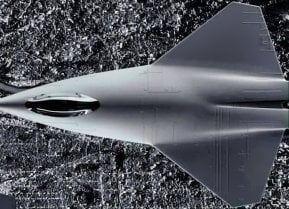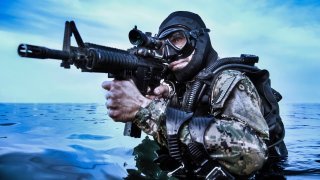Navy SEALs 'Combat Swimmers' Will Make Russia or China Sweat
As the U.S. military shifts focus to near-peer conflicts with Russia and China, special operations forces (SOF) are returning to pre-9/11 mission sets like direct action and unconventional warfare. Once rare in counterterrorism, Navy SEAL combat swimmer operations are critical in conflicts with capable naval adversaries.
Summary and Key Points: Navy SEALs are reviving combat swimmer operations as the U.S. military shifts focus from counterterrorism to near-peer conflicts against adversaries like Russia and China.
-These missions involve stealth attacks on enemy naval targets, such as warships, submarines, or maritime infrastructure, often located near shores or ports.
-In contrast to land-based counterterrorism missions, combat swimmer operations demand underwater infiltration, where SEALs may place limpet mines on ships or sabotage critical maritime assets without surfacing.
-The complexities of these missions include navigating vast distances underwater, equipment challenges, and the high risk of detection, requiring extensive training and preparation.
Adapting Special Operations: Combat Swimmer Missions in Near-Peer Conflicts
The U.S. military has shifted its focus from counterterrorism operations to near-peer conflict against adversaries such as Russia and China.
A logical consequence of this shift is a rethinking of special operations missions. The special operations forces (SOF) mission sets will undoubtedly return to those dominant before the pre-9/11 era: direct action against conventional military forces and targets; unconventional warfare in support of wider strategic military objectives; special reconnaissance against both strategic and battlefield tactical targets; and other operations as required to support conventional military operations and objectives.
One of the Navy SEAL Team missions that falls squarely into the direct action category is combat swimmer operations. While these have been virtually unheard of in the era of counterterrorism operations, they would no doubt feature to some degree in a future war with a military peer possessing a capable navy. There are no al-Qaeda naval assets to target and destroy, nor ISIS ports to infiltrate and sabotage, but there sure are plenty of naval targets in both China and Russia.
In a war against China, for example, the United States would face thousands of miles of Chinese coastline. The harbors, naval bases, and ports situated along them are all ripe targets for naval special operations forces to prosecute should the United States and China go to war. The same is true for Russia.
The purpose of combat swimmer operations
The goal of a combat swimmer operation is to attack an enemy naval target, usually situated in a port or near a shore. Those targets might include submarines, warships, naval support vessels, or even maritime infrastructure such as ports, docks, or other fixed structures along the shoreline that support an enemy’s naval operations or maritime commerce. On the other hand, an enemy ship at sea would be a target for the larger navy to prosecute with surface, air, or subsurface assets, not so much for a SEAL team.
What goes into making them happen
A combat swimmer operation is similar to any other SOF mission when it comes to the mission-planning process. An operational order comes down from higher command tasking a SEAL element in theatre to prosecute a target, say a Chinese aircraft carrier in port. If it is a maritime target, as described above, the mission would almost certainly be assigned to a SEAL unit. (The Army’s Special Forces also have Combat Divers, but these operators use water as an infiltration method and don’t conduct actual combat swimmer attacks.)
The SEAL element would plan the mission the same way it plans every mission, the main distinguishing factor would be the added complexity of an underwater infiltration, or one that is some combination of air, surface, and underwater infiltration.
By way of our carrier example, a SEAL platoon might decide they will insert from a helicopter or submarine located far offshore. They would then use small combat rubber raiding craft to further infiltrate closer to shore. The raiding craft would drop combat swimmer pairs for the final underwater infil to the target. They can also infiltrate with the help of Special Warfare Combatant-Craft Crewmen (SWCC). (SWCCs are a naval special operation unit specializing in the use of small crafts.)
The actual attack could occur by the placement of limpet mines on the hull of the naval vessel in port, in which the swim pairs place their explosives and never surface. The attack could also entail the combat swimmers surfacing and placing explosives on a target adjacent to the water.
If the attack itself was an assault or raid involving small arms and the prosecution of a target above the surface of the water, then the SEAL team could prosecute the target, and return to the water for exfiltration, or they might be extracted via some alternative direct method such as a helicopter. However, missions that take place above the water’s surface are more aptly described as an “over-the-beach” infiltration and direct action (DA) raid than a true combat swimmer operation. A combat swimmer op generally means the target is in the water and the attacking element does not leave the water or even surface from below.
When the target is successfully destroyed, sabotaged, or incapacitated in some way, the combat swimmers will often already be well into their exfiltration from the target area as they would not want to be close to an exploding naval ship, for example. The SEALs could then exfiltrate the target area in the exact reverse manner they infiltrated, or use different assets, depending on the mission and available resources.
The risks of combat swimmer operations
Combat swimmer operations carry the same risks as any other SOF mission. These can include botched navigation to the target, equipment failure, communications breakdowns, enemy contact on infiltration or at the target, failure to successfully prosecute the target, and many more contingencies.
But there are added risks associated with the underwater portion of the operation: Swim pairs can get lost and run out of air navigating to the target; they can have equipment failures below the surface; can fail to place explosives on the correct target (ships look mighty similar when viewed from below the water line); or they can be discovered on target while placing explosives. All of these risks make combat swimmer operations highly complex and perilous, which is why they require hundreds of hours of training and preparation before a maritime SOF element even arrives in theatre.
Combat swimmer operations are a capability that most U.S. military combatant commanders likely highly value within their tactical and strategic quivers. However, in today’s U.S. military, most probably have limited experience or knowledge of the execution of these operations or the actual capabilities of the SEAL elements that carry them out.
Similar to how SOF combat commanders had to rapidly adapt to a new operating environment during the Global War on Terror, conventional force commanders fighting near-peer wars in the future will have to quickly figure out the best way to use their SOF assets. Such is the way wars are generally fought, with the nations able to adapt the quickest often proclaimed the victors.
This article was originally published in July 2023 by Sandboxx News.
About the Author
Frumentarius is a former Navy SEAL, former CIA officer, and currently a battalion chief in a career fire department in the Midwest.


